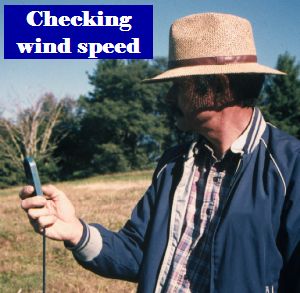Weather Conditions When Spraying
go.ncsu.edu/readext?298625
en Español / em Português
El inglés es el idioma de control de esta página. En la medida en que haya algún conflicto entre la traducción al inglés y la traducción, el inglés prevalece.
Al hacer clic en el enlace de traducción se activa un servicio de traducción gratuito para convertir la página al español. Al igual que con cualquier traducción por Internet, la conversión no es sensible al contexto y puede que no traduzca el texto en su significado original. NC State Extension no garantiza la exactitud del texto traducido. Por favor, tenga en cuenta que algunas aplicaciones y/o servicios pueden no funcionar como se espera cuando se traducen.
Português
Inglês é o idioma de controle desta página. Na medida que haja algum conflito entre o texto original em Inglês e a tradução, o Inglês prevalece.
Ao clicar no link de tradução, um serviço gratuito de tradução será ativado para converter a página para o Português. Como em qualquer tradução pela internet, a conversão não é sensivel ao contexto e pode não ocorrer a tradução para o significado orginal. O serviço de Extensão da Carolina do Norte (NC State Extension) não garante a exatidão do texto traduzido. Por favor, observe que algumas funções ou serviços podem não funcionar como esperado após a tradução.
English
English is the controlling language of this page. To the extent there is any conflict between the English text and the translation, English controls.
Clicking on the translation link activates a free translation service to convert the page to Spanish. As with any Internet translation, the conversion is not context-sensitive and may not translate the text to its original meaning. NC State Extension does not guarantee the accuracy of the translated text. Please note that some applications and/or services may not function as expected when translated.
Collapse ▲ Nothing affects pesticide applications as much as weather conditions while spraying. Weather may change through the course of the day, so be sure to watch if conditions deteriorate so that you can stop an application.
Nothing affects pesticide applications as much as weather conditions while spraying. Weather may change through the course of the day, so be sure to watch if conditions deteriorate so that you can stop an application.
- Wind speed and direction. Application wind speeds should be between 2 and 10 mph and blowing away from sensitive areas. A handheld anemometer will help monitor wind speed before and during application.
- Rainfall. Most insecticides are effective once the product has dried on the foliage. Some products require longer drying times, and this information will be provided on the label. Be sure to track approaching rain showers so you can stop spraying in time and materials are not washed off of trees before they have a chance to work.
- Air temperature and humidity. The air temperature will determine how quickly spray droplets will dry. High temperatures and humidity may also result in phytotoxicity and foliage burn.
- Time of day. In the mountains, airflow up or down slopes can affect spray deposition, especially with airblast mistblowers. In the evenings and night, the air is typically settling towards the ground, and the spray will remain in trees.


